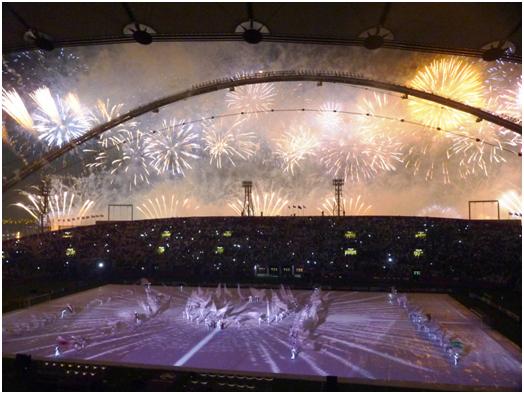Qatar: Ticketing Controversy overshadows the Final
As the 2011 Asian Cup draws to its conclusion, I wonder what we have learnt from it, how this will affect the future of Asian Football, and also what this may mean for the World Cup when it comes to this tiny Emirate, the smallest country to stage the tournament.
But first, the quarter finals. In my last blog on the subject, I felt I could not see beyond group winners Japan and Uzbekistan winning the first pair, whereas the second set of matches would be much closer. In this I was correct, although none of the quartet provided a team with an easy route through.
The first match saw almost 20,000 at Al Gharafa as the hosts Qatar met Group B winners Japan. For Qatar, it would be their foreign born stars that held the key, and Sorria, born in Uruguay gave them an early lead, from an apparently offside position.
Shinji Kagawa restored parity soon afterwards, getting his head to a loose ball after Shinji Okazaki had tried to lob the home keeper.
With 27 minutes to play, Japan’s Moshida picked up his second yellow card, and from the resultant free kick, Fabio Cesar was to bundle Qatar back into the lead.
Japan would not take this lying down, and Kagawa again was on hand to level the scores, and then to claim the assist as Inaho scored the winner in the final minute.
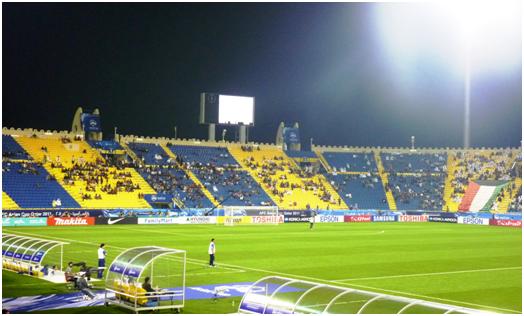
An Earlier stop at AL Gharafa
At Khalifa, Uzbekistan reward for winning the group was a match against Jordan. Scoreless at the break, the Uzbeks then took a two goal lead within five minutes of the restart both scored by Ulugbek Bakayev. Ten minutes later Bashir Bani Yaseen pulled one back for Jordan, but this was not to be enough and Uzbekistan went through.
Friday is a non working day in Qatar, so crowds were down again for the Saturday games. Only 7000 for South Korea and Iran, an intriguing contest between two teams meeting at this stage for the fifth successive time. It was unlikely there would be much between the teams and so it proved, with the only goal scored by Korean substitute Bit Garam Yoon midway through extra time.
A slightly larger crowd was at Al Sadd to see the Australians take on holder Iraq, and they had to wait even longer for a goal, the only one coming two minutes from the end of extra time, with Harry Kewell heading in a cross from Matt McKay.
And so on to the salient questions. Can Qatar hold a World Cup, and what will it be like for players and spectators? We can leave out the question of whether the cup should have been awarded here, as that is now in the past, and cannot be changed. I have no doubt that some journalists are still looking for the answers to why the Cup will be in Qatar.
Qatar can build things, so I feel safe in saying the stadiums will be built, and they will be of sufficient standard and numbers for the World Cup. More hotels and apartment buildings will be built, and there will be accommodation for those who can afford to stay. The infrastructure will improve. By 2022 there will be more roads, (but just as many traffic jams), and hopefully a rail and metro system as well.

Mall Life 1 inside the City Centre Mall
Everything will look good from a distance, but it may not stand too close scrutiny. On our trip we found much unfinished paving, even around finished projects, while more of the paving of the famous Corniche is broken than unbroken. In may other places we found that projects while ostensibly complete, had little faults that needed attention. Our hotel was a case in point. Failures of management and supervision the inability to fix a leak, or provide the correct number of fresh towels, despite reminders gave us a poor impression of what was otherwise a good hotel.
The problem is in the way Qatari society is structured. The locals, on the whole are the owners of everything, and have great riches thanks to the oil boom. The work is done by the expatriate guest workers. The workers therefore are only there for the money, they put up with poor living and working conditions so long as they can make more money than at in their homeland, and send a surplus back to their families.
Naturally, there are some foreign workers coming into more senior positions, in management and engineering but all the expats know their livelihood depends on not offending the bosses. This means there are very few people around that will say to the Qataris things like “This is not working” or “This is not the correct design”. Quite likely those that try to do this, soon find themselves looking for new employment.
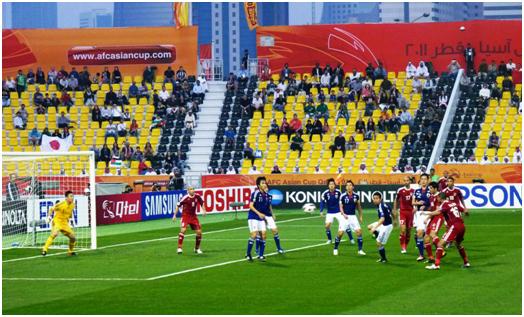
The result is, at one end of the scale annoying faults in the hotel, but at the other end a piece of jagged metal sticking out of the ground, along an unfinished and unlit pathway between the road and Al Rayyan stadium, meaning one of our party suffered a painful gash on his leg, which needed medical attention.
For most of those that visit Qatar, the prospect is to spend time in comfortable, but expensive hotels. There is no sign of cheap options being made available, and if the tournament is held in the summer (as planned), then camping would not be an option. In January or February, it is a different matter.
Qatar is not cut off from the World, and is quite used to seeing foreigners walking down the street. They expect some respect to their customs, which generally means modest dress when one wanders around the city. Neither short skirts nor shorts are common. The exception seems to be the Corniche, where it seems quite acceptable for joggers and others taking their morning exercise to show some leg.
At the moment, alcohol sales are limited to a few bars in a few of the bigger hotels. One needs to show ID to get in, and there is a big disincentive for those thinking of getting drunk. The cheaper beers are around £6/pint. The good stuff costs more. I am sure that by 2022, there will have been some thought given to allowing the visiting football fans to get their drinks. I am sure prices will stay high, but there will be more availability.
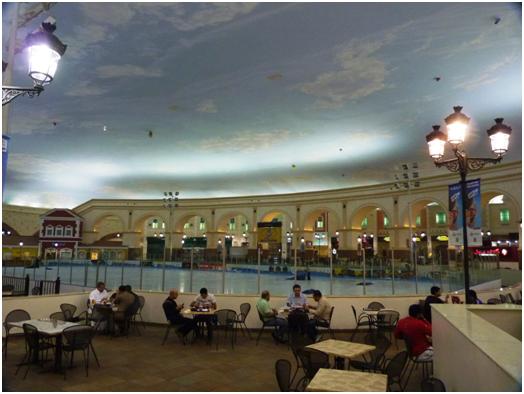
Mall Life2 Painted Ceilings
The real problem for football fans visiting Qatar during 2022 will be what to do when not watching football. At recent World Cups, just to see three group matches involves a serious amount of travelling and changing hotels. There has been a varied amount of sightseeing available around the country, and then the fans meet up socially, (and tend to drink a little).
In Qatar, it will be possible to pick a single base within Doha, and get to all the games without ever changing hotels. One can wander around the Corniche, Souq and a couple of museums in Doha, and spend a day or two on a desert safari. After that, there is nothing except the social and alcoholic options, and the football.
With two matches every day in the Asia Cup, the committed groundhopper keeps busy by seeing games every day. Even with this hectic schedule, we still had time to see most of the sights. At the World Cups in Germany and South Korea, I was more than happy to see matches such as Sweden v Trinidad & Tobago and Poland v USA but the average football fan has little interest in these games. Even if tickets are much cheaper than recent world cups, fans will not be interested in many games beyond his own national team.
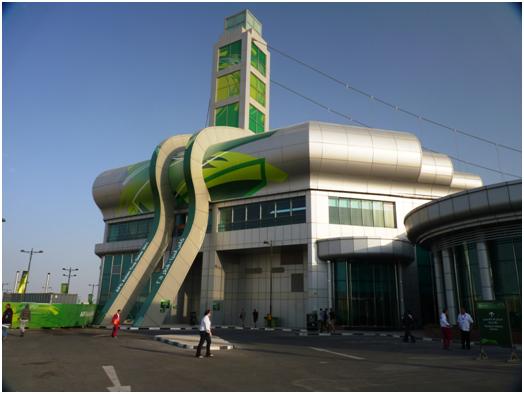
It is a football stadium! (Al-Sadd)
Even though Qatar is a peninsular with a long coastline, it is very short on beach resorts. The option of sitting around the pool with a cocktail and not leaving the hotel grounds for days at a time is hardly an option here. Even in the best run tournaments, there is always the risk that groups of fans can decide to make their own “entertainment”, and that this involves confrontation.
Enough of that for now, as the semi-finals have come and gone, and must be worth a mention, South Korea against Japan was the match I would have most liked to see, possibly as a final. The locals did not agree with me, and only 16,171 made their way to the Al Gharafa stadium for the first semi. It was a match requiring a stern referee, who knew what was and was not a penalty. It got Saudi Arabian Khalil Al Ghamdi. I do not know how good he is, as his only earlier game was the innocuous contest between South Korea and India, which I had not seen. He is experienced, having been at the last World Cup (nine yellow cards and one red in the Switzerland v Chile game). What I can say is that his penalty decisions this time were bitterly disputed.
The first was for South Korea, and involved Park Ji Sung being barged off the ball. The penalty given was hotly disputed, but this did not bother Ki Sung Yoo, who slotted the ball away. Ki then courted controversy by running towards the nearest camera and making “monkey gestures”, pulling and scratching his face. These are considered inflammatory to the Japanese, and the Celtic midfielder admitted reacting to a Japanese military flag held aloft in the stadium, but later suggested that his gesture was a reply to taunts from St Johnstone fans while he was playing for Celtic.
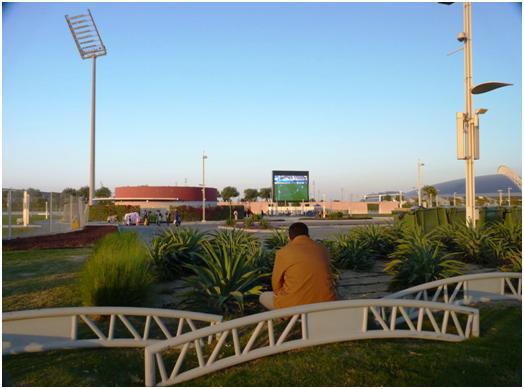
A lone spectator watches a game on a big screen, just outside the Khalifa Stadium. He cannot get closer as the car park between him and the screen is a “family area” with more guards outside, than people inside. The only other screen was in the Fun Zone, (which one has to pay to enter, and again has more guards than guests) and this was positioned badly in the glare of the afternoon sun
South Korea soon had an appeal for a second penalty, again for a foul on Park Ji Sung, brushed aside before Japan levelled the scores through Ryoichi Maeda, slotting away a pass from Nagatomo. The second half was quieter in nature and led preceded the storm that was extra time. Hwang Jae-Song blocked Shinji Okazaki, making contact just outside the box, but the Japanese midfielder managed to fall the other side of the line, and another penalty was awarded.
Keisuke Honda’s kick was poor and game off the feet of Jung Sung-Ryong, but the fastest to react was Hajime Hosogai, who gave Japan the lead. This was held until the very end of extra time, when Hwang Jae-Song redeemed himself for the foul by thrashing home the loose ball after a goalmouth scramble.
The shootout was a victory for Japan’s Eiji Kawashima, who saved two Korean shots. Honda, despite having failed with his penalty during the game, made good with the first shot for Japan, then Koo Ja Cheol had his attempt saved. Okazaki made it 2-0, and a further save was made from Lee Yong-Rae’s shot. South Korea may have had some hope when Nagatoma failed to convert his penalty, but this was short lived as Hong Jeong-Ho missed the target. Yusuyuki Konno, who had conceded the foul for South Korea’s opening goal, was Japan’s fourth penalty taker, and gave them an unassailable 3-0 lead.
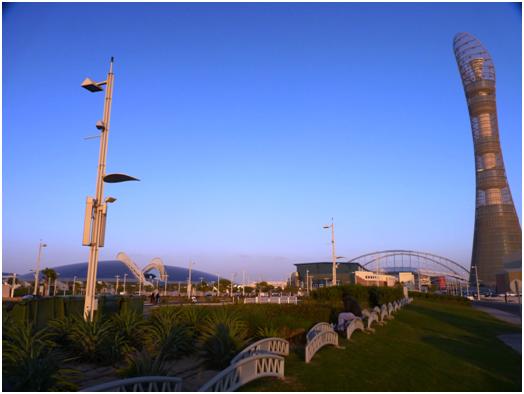
The Aspire Zone on the left are two indoor arenas, one containing a swimming pool. The arches are the Khalifa stadium, while the big tower, known as the “Torch” contains restaurants and conference rooms
This was followed by Uzbekistan against Australia, (no time to get between games, but just enough for an advertising break if viewed on TV), played in front of a half full Khalifa stadium (given as 24,826). The Uzbeks were short of two key players influential forward Aleksandr Geynrikh, and goalkeeper Ignatiy Nesterov. Both had been substituted during their quarter final. Ulugbek Bakayev, who had not played in the group games, but then partnered Geynrikh in the quarter final, (scoring both goals), started up front with Maksim Shatskikh. Shatskikh had himself missed out on the quarter finals. Temur Juraev, who came on for Nesterov in the quarter final continued between the sticks. It is fair to say that the Australians had been fortunate on the injury front, and fielded their strongest XI.
The Uzbek defence was soon found wanting, as Harry Kewell, attacking down the left put Australia into the lead after just five minutes. Ognenovski added a second before the break, and then the floodgates burst, as Bakayev received a second yellow card, and Australia added four more goals in the final 25 minutes.
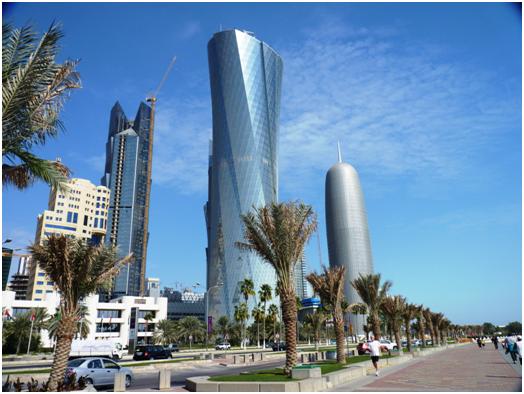
From the Corniche, the new towers compete for attention
The official crowd given for the final was around 37,000 indeed exactly one more person was recorded at this match than for the opener at the same stadium. The veracity of the figures are somewhat in doubt, despite the use of computerised turnstiles, which should accurately record the numbers in the stadium.
Throughout the tournament, the ticketing and attendances have been questioned. Some of the crowds given have been very small, but eye-witnesses have suggested the numbers in the stadium are even smaller. For the first two India games at Al-Sadd, people looking for tickets were turned away, but official figures show 25% (around 3000) seats empty. Once inside the stadiums, confusing reigns, as the stewarding is not sufficient to send individuals to the correct seats. Many were told to “sit anywhere”, and hence ended up taking seats in a higher pricing category than they had paid for. Later arrivals, having paid for these seats would have no assistance in moving people from their allocated seats, or finding suitable alternatives.
Meanwhile, there was criticism of the low numbers in attendance. The actual crowd figures were very variable, but a few matches had astonishing low crowds. Some of this is due to the compact nature of the tournament, meaning locals would pick and choose which matches to go to. The matches involving Qatar, and those involving countries with large numbers of expats (notably India and Syria) all got good crowds.
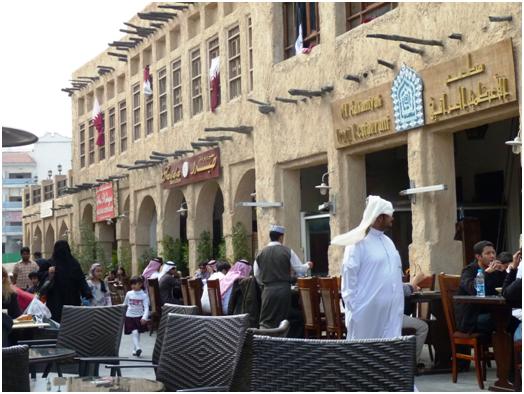
Restaurants in the Souq. In many places, a local cannot order a meal in his own language, as many waiters do not speak Arabic
Although Football is the number one spectator sport in Qatar and the country has a professional league it does not publish its attendance figures.
Anyway, for the final, it appears the authorities were nervous of the idea of empty stands being shown on worldwide TV for this showpiece event. They will have known the numbers of advance ticket sales, but either this was insufficient, or they felt many would fail to turn up, with the match on television, and Qatar already eliminated.
SO in the hours before kick-off, a large number of people were admitted into the stadium without tickets. Some reports suggest students were encouraged to take up the opportunity.
The stadium is next to the country’s most popular shopping mall, and on a Saturday evening, this means heaving. With this and a big match in proximity, parking is at a premium, and the area’s road system soon gets clogged with traffic. Most locals should know that this is a problem, and plan accordingly.
And then, the Emir arrives. As always the ruler of the country arrives under strict security, and not long before the event starts. All the other gates to the stadium are closed during this time. Reports say that the gates did not open again, even though many ticket holders were left outside.
After initially denying that anything untoward had happened, the organisers first admitted 700 ticket holders had been denied entry, and now accept the numbers are somewhat greater possibly around 3000. Ticket holders can now get a refund of their admission price, (but not of course, any other expenses incurred).
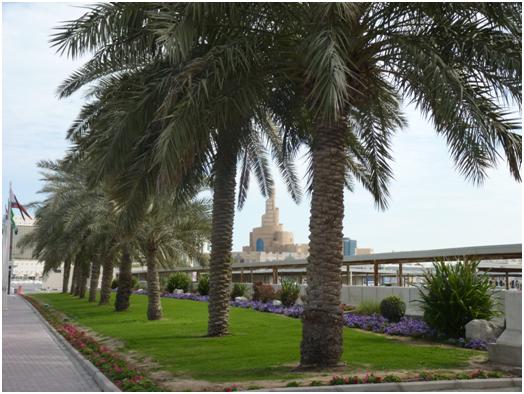
For the final, Japan were without the injured Shinji Kagawa, whose foot injury will mean missing most or all of the rest of Borussia Dortmund’s season. Australia had the best of the game, and the man of the match was given as Japanese goalkeeper Eiji Kawashima. For Australia, Matt McKay had another good game (which must push him onto European club radar). McKay is one of the few “Socceroos” to have spent his career with Australian teams, except for short loan periods in Korea and China.
Only later in the second half did Japan really get into the game, with Shinji Okazaki coming close. Okazaki has been one of the (relatively few) discoveries of the tournament, and has since moved to Stuttgart. The match by a single goal in the second period of extra time, Nagatomo found space on the left flank and crossed to substitute Tadanari Lee, who hit a first time volley which flew into the net.
Although those on the pitch were probably enough, the evening was finished with more fireworks off the pitch (and some complaining they were kept in the stadium against their will).
